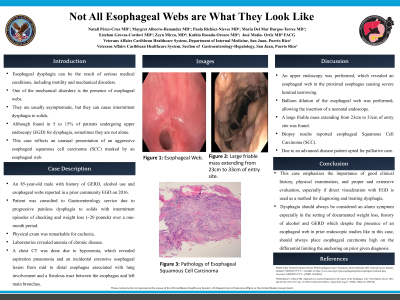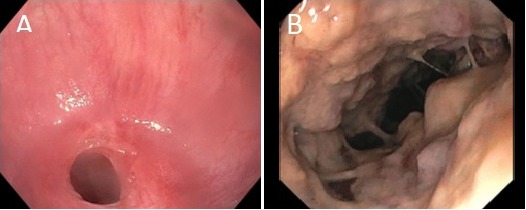Monday Poster Session
Category: Esophagus
P1878 - Not All Esophageal Webs are What They Look Like
Monday, October 23, 2023
10:30 AM - 4:15 PM PT
Location: Exhibit Hall

Has Audio
- NP
Natali Perez-Cruz, MD
VA Caribbean Healthcare System
San Juan, PR
Presenting Author(s)
Natali Perez-Cruz, MD, Maygret Alberro-Hernandez, MD, Paola Richiez-Nieves, MD, Maria Del Mar Burgos-Torres, MD, Esteban Grovas-Cordovi, MD, Zeyn Mirza, MD, Kathia Rosado-Orozco, MD, Jose Martin-Ortiz, MD, FACG
VA Caribbean Healthcare System, San Juan, Puerto Rico
Introduction: Esophageal dysphagia can be the result of serious medical conditions, including motility and mechanical disorders. One of the mechanical disorders is the presence of esophageal webs. These are indentations of the esophageal wall that may partially occlude the esophageal lumen. They are usually asymptomatic, but they can cause intermittent dysphagia to solids. Although found in 5 to 15% of patients undergoing upper endoscopy (EGD) for dysphagia, sometimes they are not alone. This case reflects an unusual presentation of an aggressive esophageal squamous cell carcinoma (SCC) masked by an esophageal web.
Case Description/Methods: This is the case of an 85-year-old male with history of GERD, prior alcohol use and esophageal webs reported in a prior EGD in 2016, he was consulted to the Gastroenterology service due to progressive painless dysphagia to solids with intermittent episodes of chocking and weight loss of around 20 pounds over a one-month period. He denied fever, chills, nausea, vomiting, odynophagia, or abdominal pain. The physical exam was remarkable for cachexia. Laboratories revealed anemia of chronic disease. During the hospitalization, due to persistent hypoxemia a Commuted Tomography (CT) was performed which revealed aspiration pneumonia and no pulmonary embolism, however an extensive esophageal lesion from mid to distal esophagus associated with lung involvement and possible fistulous tract between esophagus and left main bronchus was reported. An upper endoscopy was performed for further evaluation, which revealed an esophageal web in the proximal esophagus causing severe lumen narrowing, dilation of the esophageal web was performed using a balloon which allowed the insertion of a neonatal endoscope. A large friable mass extending from 23cm to 33cm of entry site was found. Biopsy results reported esophageal Squamous Cell Carcinoma (SCC). Due to an advanced disease patient opted for palliative care.
Discussion: This case emphasizes the importance of good clinical history, physical examination, and proper and extensive evaluation, especially if direct visualization with EGD is used as a method for diagnosing and treating dysphagia. Dysphagia should always be considered and alarm symptom especially in the setting of documented weight loss and history of alcohol and GERD which despite the presence of an esophageal web in prior endoscopic studies like in this case, should always place esophageal carcinoma high on the differential limiting the anchoring on prior given diagnosis.

Disclosures:
Natali Perez-Cruz, MD, Maygret Alberro-Hernandez, MD, Paola Richiez-Nieves, MD, Maria Del Mar Burgos-Torres, MD, Esteban Grovas-Cordovi, MD, Zeyn Mirza, MD, Kathia Rosado-Orozco, MD, Jose Martin-Ortiz, MD, FACG. P1878 - Not All Esophageal Webs are What They Look Like, ACG 2023 Annual Scientific Meeting Abstracts. Vancouver, BC, Canada: American College of Gastroenterology.
VA Caribbean Healthcare System, San Juan, Puerto Rico
Introduction: Esophageal dysphagia can be the result of serious medical conditions, including motility and mechanical disorders. One of the mechanical disorders is the presence of esophageal webs. These are indentations of the esophageal wall that may partially occlude the esophageal lumen. They are usually asymptomatic, but they can cause intermittent dysphagia to solids. Although found in 5 to 15% of patients undergoing upper endoscopy (EGD) for dysphagia, sometimes they are not alone. This case reflects an unusual presentation of an aggressive esophageal squamous cell carcinoma (SCC) masked by an esophageal web.
Case Description/Methods: This is the case of an 85-year-old male with history of GERD, prior alcohol use and esophageal webs reported in a prior EGD in 2016, he was consulted to the Gastroenterology service due to progressive painless dysphagia to solids with intermittent episodes of chocking and weight loss of around 20 pounds over a one-month period. He denied fever, chills, nausea, vomiting, odynophagia, or abdominal pain. The physical exam was remarkable for cachexia. Laboratories revealed anemia of chronic disease. During the hospitalization, due to persistent hypoxemia a Commuted Tomography (CT) was performed which revealed aspiration pneumonia and no pulmonary embolism, however an extensive esophageal lesion from mid to distal esophagus associated with lung involvement and possible fistulous tract between esophagus and left main bronchus was reported. An upper endoscopy was performed for further evaluation, which revealed an esophageal web in the proximal esophagus causing severe lumen narrowing, dilation of the esophageal web was performed using a balloon which allowed the insertion of a neonatal endoscope. A large friable mass extending from 23cm to 33cm of entry site was found. Biopsy results reported esophageal Squamous Cell Carcinoma (SCC). Due to an advanced disease patient opted for palliative care.
Discussion: This case emphasizes the importance of good clinical history, physical examination, and proper and extensive evaluation, especially if direct visualization with EGD is used as a method for diagnosing and treating dysphagia. Dysphagia should always be considered and alarm symptom especially in the setting of documented weight loss and history of alcohol and GERD which despite the presence of an esophageal web in prior endoscopic studies like in this case, should always place esophageal carcinoma high on the differential limiting the anchoring on prior given diagnosis.

Figure: A. Dilation of the esophageal web
B. Mid esophagus
B. Mid esophagus
Disclosures:
Natali Perez-Cruz indicated no relevant financial relationships.
Maygret Alberro-Hernandez indicated no relevant financial relationships.
Paola Richiez-Nieves indicated no relevant financial relationships.
Maria Del Mar Burgos-Torres indicated no relevant financial relationships.
Esteban Grovas-Cordovi indicated no relevant financial relationships.
Zeyn Mirza indicated no relevant financial relationships.
Kathia Rosado-Orozco indicated no relevant financial relationships.
Jose Martin-Ortiz indicated no relevant financial relationships.
Natali Perez-Cruz, MD, Maygret Alberro-Hernandez, MD, Paola Richiez-Nieves, MD, Maria Del Mar Burgos-Torres, MD, Esteban Grovas-Cordovi, MD, Zeyn Mirza, MD, Kathia Rosado-Orozco, MD, Jose Martin-Ortiz, MD, FACG. P1878 - Not All Esophageal Webs are What They Look Like, ACG 2023 Annual Scientific Meeting Abstracts. Vancouver, BC, Canada: American College of Gastroenterology.
